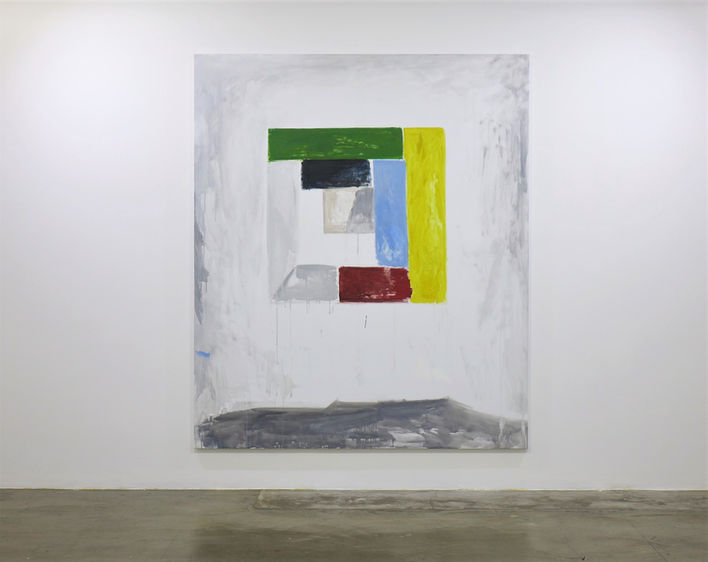.jpg)
Solo Exhibition
SOLITUDE
May 6 - June 25, 2022, Choi&Choi Gallery, Seoul, South Korea
샌정의 작업은 회화에 대한 끊임 없는 탐구를 캔버스 안에 붓으로 구축한 세계를 바탕으로 시각화 한다. 회화 작업 중 발생하는 수많은 감정, 사유, 현상들을 담아내는 작가의 그림은 이번 전시에서 ‘고독’(solitude in a massive frontality) 이라는 중심점을 통해 다시 한 번 재해석 된다.
이전 자신의 작업에 대해 논하며 “작품은 필연적으로 고독한 시간을 필요로 하는 것 같습니다.”라고 말했던 샌정에게 고독이란 낯선 주제가 아니다. 작가는 오전에는 그 전날의 작품을 긴 시간동안 응시하며 내재된 것들을 받아들이는 시간을 가지고, 오후에는 또 다시 붓을 잡으며 많은 시간을 오로지 회화라는 동반자와 함께 보낸다. 홍익대 미술대학, 뒤셀도르프 쿤스트아카데미, 첼시 컬리지 오브 아트를 거치며 회화의 역사 속 다양한 아이디어와 도그마를 공부하고 런던 내셔널 갤러리에 올드 마스터들의 거작을
접하며 회화의 본질에 다가가기를 도모해온 그는 구상과 추상의 작업을 병행하며 자신만의 미학을 개척하였고, 시간을 두고 재해석의 과정을 거치며 특유의 절제된 추상적 화풍에 도달하였다. 그러한 작가의 시각적 언어는 표면적으로 모더니즘의 기하학적 추상과 동양 회화적인 여백의 미를 나타내는 듯 하지만, 긴 시간 동안 회화와의 고독 속에서 그가 맺은 관계의 결과물을 제시한다. 이러한 고독은 샌정의 작품 한 점 한 점의 내면에도 존재한다. 한 그림을 마주하며 오로지 그 그림에 대한 사유만이 남아 소용돌이 치는 정신적 상태를 화폭에 담는 작가는 사각형의 프레임으로 구축된 캔버스 고유의 형이상학적 공간 안에서 부유하고 있는 사유들을 기본적인 형태로 함축하고 시각화 한다. 그러나 이러한 형태들은 이 고립된 공간 안에서 정착되어 있지 않으며, 서로 충돌하고, 조화를 이루고, 때로는 흐려지는 유동적인 모습으로 작가의 번뇌를 고스란히 담아낸다. 이렇듯 작가의 작업은 회화에 대한 분석적인 연구와 창작자로서의 서정적인 감정들, 감성과 이성, 불안과 확신이 반복되는 ‘긍정적인 불균형’을 토대로 이루어지며, 작품의 완성 또한 특정의 시각적 목표가 아닌 그저 하나의 회화적 생태계가 충분히 구축되었음을 기준으로 한다.
따라서 작가의 작업 속 세계에서 일어나는 현상과 감정은 모두 제각각 다르지만, 그는 그렇게 독립된 세계들을 이번 전시에서 ‘고독’이라는 통일된 지주로 수렴하여 연작의 작품들로 보여준다. 평소에도 작업과 항상 함께 해왔던 고독은 주제화되며 더욱 선명해지고 흐르는 시간 속에서 견고해진다. 그러한 고독 속에서 머물고 일렁이는 사유와 현상, 오직 고독 속에서만 직면할 수 있는 이러한 것들(drama, phenomena)을 사각의 응집된 형태로 가시화한 이 작품들은 오랜 시간의 작업과 탐구에서 태어난 하나의
구체적인 결실을 전달하는 듯 보인다. 외로움이 아닌 고독이 선사하는 이 미학은 우리에게 샌정이 어떠한 예술가인지 이해할 수 있는 최상의 실마리가 된다.
Sen Chung’s work starts from his constant exploration of the art of painting, visualized as cosmos built within the canvas. The artist's body of work, which captures the plethora of emotions, thoughts, and phenomena that occur during the process of painting, is reinterpreted in this exhibition around the central theme of ‘solitude in a massive frontality’.
Solitude is not an unfamiliar topic for Sen Chung. While discussing his work in an earlier interview, Chung has commented that "painting inevitably requires a time of solitude.” The artist spends his mornings facing the works in progress from the previous day in order to take in what has occurred, and picks up the brush again in the afternoon to tackle what is left. Throughout this cyclicality, only painting remains as his constant companion. Sen Chung studied various ideas and dogmas throughout art history at Hongik University College of Fine Arts, Düsseldorf Kunst Academy of Art, and Chelsea College of Art & Design, and frequently visited the masterpieces of the Old Masters in the National Gallery in London, all in an attempt to approach the essence of painting. Sen Chung simultaneously explored both figurative and abstract painting early on in his career, and went through a process of readjustments over time to develop the current aesthetic of refined abstraction. While his visual lexicon seems to borrow from the geometric abstraction of Modernism and the Eastern tradition of emphasizing the empty space, his paintings are a culmination of the deeply personal relationship with painting that the artist has cultivated over his decades-long practice. Solitude also exists within each and every piece of Sen Chung’s painting. Working on one painting at a time, the artist captures the swirling emotions and ideas specific to that piece, and visualizes them as elemental shapes and colours that float within the metaphysical realm bound by the rectangular frame of the canvas. These elements, however, are not fixed within this isolated space. Instead, they collide, harmonize, and at times disappear into the blurry ether, reflecting the mercurial conditions of the artist’s mental landscape. Sen Chung’s paintings are both analytical in its representation of the creative process, and sentimental in capturing the overwhelming thoughts and emotions that persist throughout it. Drawing their impetus from the constant cycle of
“positive imbalance” between emotionality and rationality, Sen Chung’s paintings are considered complete when a sufficient painterly ecosystem has been developed within the canvas, rather than when it reaches a certain visual conclusion.
Therefore, the phenomena and emotions that occur in each of Sen Chung’s painting are all vastly different. In this exhibition, however, the artist converges these independent worlds into a series of paintings through the unified lens of ‘solitude’. Solitude, which has always been the underlying
condition of the artist’s practice, becomes the focal point of this new body of work, solidifying as it endures the flow of time. The ideas, phenomena, and drama that dwell in solitude – and can only be perceived once embracing solitude – are crystalized into rectangular amalgams that seem to convey the concrete result of the artist’s prolonged exploration. This aesthetic born of solitude, rather than loneliness, helps the viewer take a step further into understanding the artist Sen Chung.










